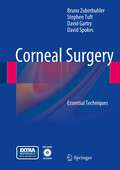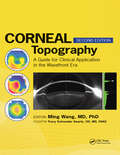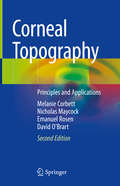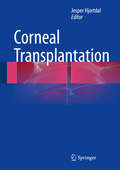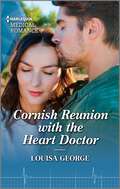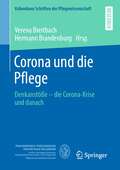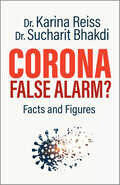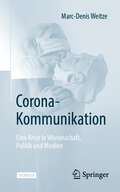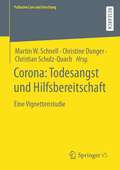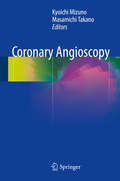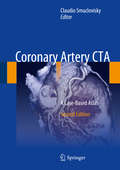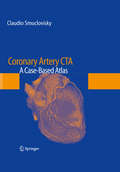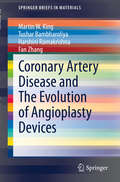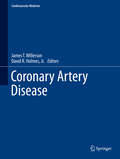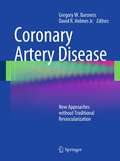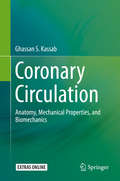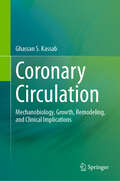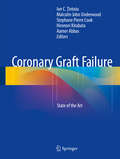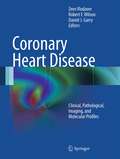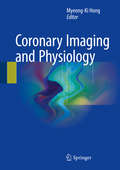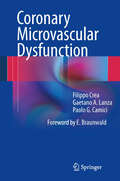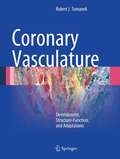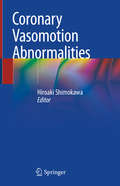- Table View
- List View
Corneal Surgery: Essential Techniques
by Bruno Zuberbuhler David Gartry David Spokes Stephen TuftThis book is an informative and comprehensive guide to the essential techniques currently employed in corneal surgery. It focuses in particular on two principal areas: the treatment of corneal disorders by means of different forms of corneal transplantation and the use of the Excimer laser to treat refractive disorders. In order to facilitate learning and later deployment of the techniques a multimedia approach is used. Surgical steps are described clearly within the book and can then be observed in detail on the accompanying high-quality DVD. A further feature is the inclusion of a chapter devoted to wet lab training, which presents practical preparatory exercises. This book will be of special value as a handy reference for ophthalmologists who are just embarking upon their surgical training. However, it will also be informative for trained eye surgeons, who will be able to compare their own practice with the presented procedures and to assimilate the latest techniques.
Corneal Topography: A Guide for Clinical Application in Wavefront Era
by Ming WangWith the rapid advancement of corneal topography and wavefront technologies and the increased application of corneal topography not only in refractive but also in premium IOL surgery, a new edition of the best-selling Corneal Topography: A Guide for Clinical Application in the Wavefront Era will be the foremost resource for both ophthalmologists and optometrists. In this Second Edition, Dr. Ming Wang, Dr. Tracy Swartz and over 50 contributors combine the important topics of refractive and premium lens surgeries and put corneal topography in the context of wavefront technology. With over 500 images, this edition gives special attention to the latest advances in these technologies.The state-of-the-art science and application of corneal topography for these anterior segment surgeries is well represented in Corneal Topography, A Guide for Clinical Application in the Wavefront Era, Second Edition, making it the latest and most comprehensive reference of these state-of-the-art technologies for refractive and for premium IOL surgery. Topographic and Wavefront Technologies Covered Include:• Placido disc-based topographic systems• Elevation-based topographic systems• Ultrasound-based topographic systems• OCT-based topographic systems• Topography and wavefront combined systemsTopographic Applications Covered Include:• Topographies of corneal diseases, including post-RK/CK/LASIK/PRK• Topography-guided contact lens fitting• Topography application in refractive surgery and in premium IOL surgeries• Topographic guidance for corneal surgeries• Topography-guided custom treatments• Combined treatment strategies using topography and wavefront data• Future development of corneal topography in the wavefront eraUpdated and reorganized to reflect changes in the technology, Corneal Topography: A Guide for Clinical Application in the Wavefront Era, Second Edition is indispensible for all anterior segment surgeons, ophthalmologists, and optometrists.
Corneal Topography: Principles and Applications
by Emanuel Rosen Melanie Corbett Nicholas Maycock David O'BrartThe new edition of this leading text atlas on corneal topography has been updated to include the latest advances in technology, such as Pentacam and Orbscan. The principles and theory underlying each technology are first clearly explained, and clinical applications are then examined. The authors describe how to use the different technologies and devices, explain the clinical readout with illustrations of normal corneal topography, discuss applications and findings in common disease states, and present the appearances after various corneal surgical procedures. The pros and cons of each system are highlighted. This up-to-date, superbly illustrated book is the most comprehensive guide to corneal topography currently available. It is anticipated that this second edition will become the seminal corneal topography textbook for all with an interest in corneal disease and its management, and refractive surgery.
Corneal Transplantation
by Jesper HjortdalThis textbook reviews the novel techniques employed in corneal transplantation. It will assist fellows and corneal surgeons in using these techniques to best effect and in selecting patients for surgical procedures, taking into account the benefits and risks. Until 15 years ago the state-of-the art type of corneal transplantation was penetrating keratoplasty. Since the start of this millennium, however, important advances have been made in developing new surgical techniques. Today, the vast majority of keratoplasty procedures are performed as delicate lamellar procedures, either with the assistance of fine microkeratomes or femtosecond lasers or using very advanced surgical dissection procedures. Corneal Transplantation provides detailed information on these and other advances, which have helped patients undergoing keratoplasty to achieve a much faster visual recovery and a more stable eye with less risk of rejection episodes.
Cornish Reunion with the Heart Doctor
by Louisa GeorgeFind out what happens when two best friends reunite and their chemistry is almost too much to handle in Louisa George&’s latest Harlequin Medical Romance.He&’s her best friend…but could he be something more? Pediatrician Lexi can&’t wait for her friend cardiologist Jono to move home from Australia. After pouring her heart and soul out to Jono long-distance during her divorce, their emotional bond is strong, but the raw chemistry of their reunion after five years astounds her! And when a Cornish wedding leads to a night of breathtaking passion, Lexi must decide—does she dare risk their precious friendship for the hope of everything she&’s ever wanted?From Harlequin Medical: Life and love in the world of modern medicine.
Corona und die Pflege: Denkanstöße – die Corona-Krise und danach (Vallendarer Schriften der Pflegewissenschaft #10)
by Hermann Brandenburg Verena BreitbachEs ist wichtig die „Corona-Pandemie“ aus der Perspektive verschiedener Disziplinen zu betrachten. Denn eine „Lösung“ kann letztlich nur gesellschaftlich verantwortet und nicht aus der Logik einer Disziplin, z. B. der Medizin, begründet werden. Was entstanden ist aus den „Corona-Impulsen“ während des ersten Lockdowns in Deutschland im März 2020, hat sich zu einem Zeitzeugnis „nach dem ersten Hype“ entwickelt: Aus multiperspektivischer Sicht (philosophischer, soziologischer, ethnologischer, theologischer und pflegewissenschaftlicher) wird ein Blick auf die Corona-Pandemie und auf ihre langfristigen Folgen und die sich daraus ergebenden Bedarfe geworfen. „Wir haben die Pflegefachkräfte in der Corona-Krise zweimal im Stich gelassen: In der ersten Welle haben sich viele im Dienst am Menschen infiziert, weil Masken, Schutzkleidung und Konzepte fehlten. Viele von ihnen leiden bis heute unter Long Covid, was nicht als Berufskrankheit anerkannt ist. Wenn wir weiter so ignorant mit der größten und wichtigsten Gruppe im Gesundheitswesen umgehen, dürfen wir uns nicht wundern, wenn sie uns jetzt und erst recht in Zukunft überall fehlt. Mit meiner Stiftung Humor Hilft Heilen machen wir seit Jahren Workshops für die Pflege, um die seelische Gesundheit für Pflegekräfte zu stärken. Dieses Buch ist wichtig, weil es auf dieses Dilemma aus verschiedenen Perspektiven hinweist und Lösungen aufzeigt.“ Dr. Eckart von Hirschhausen, Gründer der Stiftung Humor Hilft Heilen, die sich seit 2008 für mehr Menschlichkeit in der Medizin einsetzt und „Begegnungen auf Augenhöhe – mit Augenzwinkern“ ermöglicht.
Corona, False Alarm?: Facts and Figures
by Karina Reiss Sucharit BhakdiDoes the race for vaccine development make sense? What are the chances of success? Will the vaccine be safe? Will people accept it??In June 2020, Corona, False Alarm? exploded into the German market, selling 200,000 copies and 75,000 e-books in the first six weeks.No other topic dominates our attention as much as coronavirus and COVID-19, the infectious disease it triggers. There&’s been a global deluge of contradictory opinions, fake news, and politically controlled information. Differing views on the dangers posed by the pandemic have led to deep division and confusion, within governments, society, and even among friends and family.In Corona, False Alarm?, award-winning researchers Dr. Sucharit Bhakdi and Dr. Karina Reiss give clarity to these confusing and stressful times. They offer analysis of whether radical protective measures—including lockdown, social distancing, and mandatory masking—have been justified, and what the ramifications have been for society, the economy, and public health. Dr. Bhakdi and Dr. Reiss provide dates, facts, and background information, including:• How Covid-19 compares with previous coronaviruses and the flu virus• What infection numbers and the death rate really tell us• The challenges around lockdown: Were the protective measures justified?• Mandatory mask-wearing: Does the science support it?• Vaccines: What are the chances of success? What are the risks?Corona, False Alarm? provides you with sound information and substantiated facts—and encourages you to form your own opinion on the corona crisis.
Corona-Kommunikation: Eine Krise in Wissenschaft, Politik und Medien
by Marc-Denis WeitzeDie Beiträge der Wissenschaft in der Corona-Krise waren vielfältig. Sie reichten von der Impfstoffentwicklung über Aerosolforschung bis hin zu Modellierungen. Es gab viele Erfolgsmeldungen. Virologen wurden zu Medienstars. Wissenschaft, Politik und Medien sprachen zeitweise mit einer Stimme – ein Siegeszug der Wissenschaftskommunikation? Es gab aber auch überzogene Versprechungen, dünnhäutige Reaktionen bei Kritik und Einseitigkeit in der Politikberatung – ein kommunikatives Desaster für Wissenschaft, Politik und Medien?Dieses Sachbuch möchte die Diskussion zur Corona-Kommunikation in Wissenschaft, Politik und Medien anregen. Es basiert auf Fallstudien, die aus verschiedenen Perspektiven beleuchtet werden, ordnet Beispiele entlang der Kriterien etablierter Wissenschaftsorganisationen ein und formuliert Fragen an die künftige Wissenschaft und ihre Kommunikation.Ist dies eine Studie, Materialsammlung oder Streitschrift? Alles. Aber hauptsächlich ein Plädoyer: Gegen unantastbare Wahrheiten, Meinungshomogenisierung und Ausgrenzung. Für Transparenz, Pluralität und Dialog in Wissenschaft und Kommunikation.
Corona: Eine Vignettenstudie (Palliative Care und Forschung)
by Martin W. Schnell Christine Dunger Christian Schulz-QuachDie in diesem Buch präsentierte Studie befasst sich mit der Frage, welcher Zusammenhang zwischen der Bereitschaft besteht, in der COVID‐19‐Pandemie anderen Menschen in deren Lebensvollzug zu helfen und der Furcht vor dem Tod durch COVID‐19. Das Buch gibt eine Antwort auf die Frage nach „Solidarität in der Krise“. Im Rahmen einer Vignettenstudie werden Einwohner*innen Deutschlands mittels Online‐Fragebogen zu soziodemographischen sowie situationsbezogenen Eigenschaften und ihren jeweiligen Vignettenurteilen befragt.
Coronary Angioscopy
by Kyoichi Mizuno Masamichi TakanoThis book presents a thorough review of coronary angioscopy, ranging from instructions on its use to the latest advances. Starting with the structure and fundamental principles of angioscopy, it shows readers how to apply the image to comprehensive care of coronary-artery patients. Plentiful color photos and illustrations will enable readers to investigate and classify plaques and thrombi and to evaluate coronary stent- and drug-based therapies. The authors are leading researchers on angioscopy. This book offers the perfect guide not only for new clinicians but also for cardiologists who have already adopted this technique for medical examination and treatment. Angioscopy is a unique medical technique for visualizing the interior of blood vessels and helps physicians not only to diagnose the pathology but also to measure the effectiveness of Percutaneous coronary intervention (PCI) or antiarteriosclerotic drugs. Furthermore, the recently developed molecular angioscopy approach allows us to observe Low-density lipoprotein (LDL) oxide, collagen, and macrophages, and is rapidly growing in importance.
Coronary Artery CTA
by Claudio SmucloviskyThe second edition of this important work provides a broad range of cardiac CT angiography (CCTA) cases covering normal anatomy, congenital coronary anomalies, coronary artery disease, percutaneous coronary intervention, postsurgical coronary revascularization, and extra-coronary abnormalities. It is designed to help practicing radiologists, cardiologists, and cardiothoracic surgeons understand the current issues involved with clinical, interventional, and surgical management of coronary artery CTA. Each case consists of detailed CCTA images, a brief history, diagnosis, discussion, and pearls and pitfalls. This updated and expanded edition includes new chapters on principles of cardiac CT, patient preparation, cardiomyopathies, pediatric cardiac CT, cardiac CT in the emergency department, CT-FFR, and reporting cardiac CT.
Coronary Artery CTA: A Case-Based Atlas
by Claudio SmucloviskyThis new case-based book fills a gap in the literature by guiding the reader through the challenging clinical problems encountered in daily practice. Each case presents the clinician with a complete patient work-up that includes clinical history, radiological and clinical findings, treatment summary and suggested readings. Ideal for radiology and cardiology residents, as well as experienced physicians, this text helps the reader arrive at a diagnosis for each clinical problem presented.
Coronary Artery Disease and The Evolution of Angioplasty Devices (SpringerBriefs in Materials)
by Fan Zhang Martin W. King Tushar Bambharoliya Harshini RamakrishnaIn this concise but authoritative book, the authors take the reader through the epidemiology, risk factors and the basic mechanism of coronary artery disease. In addition, they explain how coronary microvascular dysfunction can lead to angina, even after successful angioplasty following a heart attack. The methods for diagnosis and the options for treatment are explained, ending with a discussion of the evolution of coronary angioplasty from balloon catheters to novel, fully resorbable polymeric drug eluting stents. Enclosed is a list of currently available commercial devices, as well as a listing of experimental products under research and development, so that readers can appreciate the serious nature of this disease and have an understanding of how the medical device sector is attempting to address this major healthcare problem. Globally in 2010, ischemic heart disease was the cause of 13.3% of all deaths. In the US alone, the direct medical costs from coronary artery disease and stroke are currently estimated to be $126 billion per year, and are expected to rise to $309 billion by 2035.
Coronary Artery Disease: New Approaches Without Traditional Revascularization (Cardiovascular Medicine)
by Jr. David R. Holmes James T. WillersonCardiovascular Medicine: Coronary Artery Disease will offer today's most up-to-date, user-friendly guidance on the evaluation, diagnosis, and medical and surgical treatment of this most important aspect of cardiovascular disease and will be on the wish list for every trainee and practicising cardiologist, cardiac surgeon, vascular surgeon, diabetologist, cardiac radiologist and any physician who manages cardiac patients. The book is dedicated to providing comprehensive coverage of every aspect of coronary arterial medicine from cardiac signs and symptoms through imaging and the genetic basis for coronary disease to surgery, interventions, treatment and also to preventive cardiology. The Editor - and a group of contributing world authorities - offer their decades of scientific and clinical experience. A major selling point is the consistent chapter organization, clear design, and engaging text that includes user-friendly features such as tables, lists and treatment boxes. The reader will have all the guidance to diagnose and manage a full range of conditions in a series of textbook resources, while also having access to additional video material from the integral website.
Coronary Artery Disease: New Approaches without Traditional Revascularization (Cardiovascular Medicine)
by Gregory W. Barsness David R. HolmesA book directed towards individuals with an interest in the clinical treatment of patients with unrevascularizable angina. It explores the treatment options in the setting of a sound scientific background and provides guidance and predictions for future directions in this rapidly developing field. It is the only textbook of its kind and fulfils an unmet need for practicing internal medicine, family practice and cardiovascular clinicians. It also provides a reliable reference for clinical and basic researchers interested in this topic.
Coronary Artery Disease: Therapeutics and Drug Discovery (Advances in Experimental Medicine and Biology #1177)
by Miao WangThis book provides an overview of the etiology of coronary artery disease and focuses on the main therapies and drug interventions currently available. It highlights drug pharmacology and therapeutic challenges, with a special emphasis on the underlying principles of available therapeutics and the on-going development of drugs for coronary artery disease.The book is divided into eight chapters, the first of which describes the classical mechanism of coronary artery disease and its clinical presentations. Chapter 2 lists the principles of and related evidence on the prevention and treatment of coronary artery disease. This includes diet and lifestyle management, and guidelines for the treatment of acute coronary syndrome and stable coronary artery disease. In turn, Chapter 3 describes revascularization treatments, covering percutaneous coronary interventions, coronary artery bypass grafts and thrombolysis. This chapter also addresses the main therapeutic challenges.The following chapters provide an overview of three major categories of coronary artery disease drugs, which target thrombosis (Chapter 4), lipid metabolism (Chapter 5), and hypertension (Chapter 6). Heart failure constitutes the major health burden in the late stage of coronary artery disease; accordingly, current heart failure therapeutics and related drug pharmacology are described in Chapter 7. In closing, Chapter 8 provides a summary of on-going clinical trials for coronary artery disease drug development and discusses a number of promising areas in which intensive research into new therapeutics is being pursued.Given its scope, the book will be of interest to clinicians, medical students and research scientists, as well as to pharmaceutical professionals who are seeking new therapies and drugs for coronary artery disease and related disorders.
Coronary Circulation: Anatomy, Mechanical Properties, and Biomechanics
by Ghassan S. KassabThis comprehensive text examines both global and local coronary blood flow based on morphometry and mechanical properties of the coronary vasculature. Using a biomechanical approach, this book addresses coronary circulation in a quantitative manner based on models rooted in experimental data that account for the various physical determinants of coronary blood flow including myocardial-vessel interactions and various mechanisms of autoregulation. This is the first text dedicated to a distributive analysis (as opposed to lumped) and provides digital files for detailed anatomical data (e.g., diameters, lengths, node-to-node connections) of the coronary vessels. This book also provides appendices with specific mathematical formulations for the biomechanical analyses and models in the text. Written by Dr. Ghassan S. Kassab, a leader in the field of coronary biomechanics, Coronary Circulation: Anatomy, Mechanical Properties, and Biomechanics is a synthesis of seminal topics in the field and is intended for clinicians, bioengineers, and researchers as a compendium on the topic. The detailed anatomical and mechanical data provided are intended to be used as a platform to address new questions in this exciting and clinically very important research area.
Coronary Circulation: Mechanobiology, Growth, Remodeling, and Clinical Implications
by Ghassan S. KassabThis book covers mechanobiology, growth, remodeling, and clinical implications of coronary artery disease treatment. This volume presents a comprehensive overview of coronary circulation, including growth and remodeling of coronary vasculature, implications to cardiology, and implications to cardiovascular surgery. General principles of biomechanical homeostasis and mechanobiology are outlined. Specifics topics covered include endothelial mechano-transduction, flow reversal, uniform shear, stress & strain hypotheses, scaling laws in coronary artery disease, growth, and aging, and coronary retroperfusion. Coronary Circulation: Mechanobiology, Growth, Remodeling and Clinical Implications is a vital resource for coronary physiologists and cardiovascular disease researchers and bioengineers who want to learn more about mechanobiology and clinical implications to coronary circulation in health and disease.
Coronary Graft Failure: State of the Art
by Ion C. Ţintoiu Malcolm John Underwood Stephane Pierre Cook Hironori Kitabata Aamer AbbasCoronary artery bypass surgery has been developedsince 1960s to overcome proximal coronary artery disease. Worldwide, the numberof patients that are undergoing coronary artery bypass surgery is steadilyincreasing. Depending on diverse risk factors, one fifth of grafts are occludedat 1 year. For the remaining, graft patency last usually 8-15 years. This bookbrings together the main specialists in the field to review the currentevidence on epidemiology, pathophysiology, diagnostic, new imaging techniquesand specific therapeutic modalities. This volume aims to update a complex subjectrepresented by coronary graft failure. The authors of this monograph areinterventional cardiologists, cardiovascular surgeons and research scientists,who will be creating four parts and 71 chapters that are divided in order togive a uniform interpretation of this condition including all aspects ofcoronary graft failure This book not only provides the most up-to-datedscientific evidence in the field but in a two-step manner. Each chapter isdivided into a at a glance part that reflects the basic evidence on the topic,and a "full picture" part that brings all what the advanced reader should bebrought with.
Coronary Heart Disease: Clinical, Pathological, Imaging, and Molecular Profiles
by Robert F. Wilson Daniel J. Garry Zeev VlodaverCoronary Heart Disease: Clinical, Pathological, Imaging, and Molecular Profiles presents a comprehensive picture of ischemic heart disease for practitioners, students, and investigators dealing with the varied facets of this complex subject. Individual chapters introduce the anatomy of the coronary blood vessels and cardiac development, while others consider current imaging modalities utilized for ischemic heart disease, including stress echo, nuclear diagnostic tests, non-invasive coronary artery imaging, and coronary angiography. Imaging chapters provide key clinical information on techniques and indications, and include examples of both normal and abnormal patterns. The principle thrust of the book concerns coronary atherosclerosis, the pathology of which is presented in conjunction with the results of anatomic, non-invasive imaging and angiographic studies. Related chapters cover atherogenesis, presenting new insights into the pathophysiology of the vulnerable plaque, the role of progenitor cells in vascular injury, inflammation and atherogenesis, and the genomics of vascular remodeling. Additional topics covered include angina pectoris, acute coronary syndromes, healed myocardial infarction and congestive heart failure, catheter-based and surgical revascularization, and surgical treatment of myocardial infarction and its sequelae. With contributions from a diverse group of internationally-known physicians with broad experience in the diagnosis and treatment of coronary heart disease, this book will be a valuable resource for practitioners in clinical cardiology, thoracic surgery, pathology, and cardiovascular molecular research, as well as for students in training.
Coronary Heart Disease: From Diagnosis to Treatment
by Barry CohenCoronary heart disease affects 12 million Americans. Though it is one of the most serious diseases in the nation, there are many ways to understand and treat it. Author Barry Cohen, M.D., a cardiologist who has treated thousands of patients, addresses all of the most pressing questions, including: What causes coronary heart disease? How does cholesterol affect your heart? What medical tests will you need? What are the newest diagnostic tests available? What medications are prescribed? What is involved with an angioplasty and bypass surgery? What lifestyles changes will improve your health? What are the warning signs of a heart attack? Stay healthier by becoming an informed patient.
Coronary Imaging and Physiology
by Myeong-Ki HongThis book is intended as a guide for all cardiologists who are interested in coronary imaging and physiology, a sound understanding of which is vital for the optimal performance of appropriate coronary interventions. The basics of each relevant modality are presented, with clear explanation of clinical utility and evaluation of the evidence regarding clinical outcomes. All technical methods are described in detail, and the text is complemented by numerous helpful tables and illustrations. The effectiveness of intravascular coronary imaging in improving clinical outcomes is proven, and it is widely used for this purpose. Two modalities for intravascular coronary imaging are available in clinical practice: intravascular ultrasound (IVUS) and optical coherence tomography (OCT). For coronary physiology, the pressure wire-derived fractional flow reserve (FFR) provides information on the functional status of coronary trees. This technique and its clinical applications receive particular attention in the book, which also looks beyond FFR to FFR-CT, a method using computational fluid dynamics, and to invasive assessment of the microcirculation.
Coronary Microvascular Dysfunction
by Filippo Crea Paolo Camici Gaetano LanzaIn the past two decades a number of studies have shown that abnormalities in the function and structure of coronary microcirculation can be detected in several cardiovascular diseases. On the basis of the clinical setting in which it occurs, coronary microvascular dysfunction (CMD) can be classified into four types: CMD in the absence of any other cardiac disease; CMD in myocardial diseases; CMD in obstructive epicardial coronary artery disease; and iatrogenic CMD. In some instances CMD represents an epiphenomenon, whereas in others it represents an important marker of risk or may contribute to the pathogenesis of myocardial ischemia, thus becoming a possible therapeutic target. This book provides an update on coronary physiology and a systematic assessment of microvascular abnormalities in cardiovascular diseases, in the hope that it will assist clinicians in prevention, detection and management of CMD in their everyday activity.
Coronary Vasculature: Development, Structure-Function, and Adaptations
by Robert J. TomanekIschemic heart disease is the leading cause of morbidity and mortality in the developed world. The high metabolism and oxygen demand of the cardiac myocardium depends on both a high blood flow and a rich capillary density. For this reason, the growth of the coronary vasculature is vital, not only in early development, but also in the adult faced with various stresses. Novel technologies have enabled the discovery of the molecular mechanisms underlying the growth and assembly coronary vessels, and this volume covers the hierarchy of the coronary vasculature from its embryonic origins through its postnatal growth, adulthood, and senescence. Chapters address normal coronary development, coronary anomalies and their possible underlying developmental errors, coronary vessel adaptations to exercise training, aging, hypoxia, myocardial ischemia, and cardiac hypertrophy. This comprehensive overview of current research in coronary vessels and myocardial perfusion was written by Dr. Robert J. Tomanek, Emeritus Professor of Anatomy and Cell Biology at the University of Iowa. The book reviews, discusses, and integrates findings from various areas of coronary vasculature research, and as a result, will be a valuable reference source for cardiovascular scientists and physicians for many years to come.
Coronary Vasomotion Abnormalities
by Hiroaki ShimokawaThis book reviews the latest findings on epicardial coronary spasm and coronary microvascular dysfunction (CMD), important diseases for understanding coronary artery vasomotion abnormalities. The book chiefly consists of two major parts, each of which explores the epidemiology, pathophysiology, diagnosis and treatment of the diseases. The chapters present a range of experimental and clinical studies, including the editor’s life’s work on coronary spasm; how Rho-kinase activation plays an important role in connection with the disease; how chronic adventitial inflammation is a central pathophysiology of the spasm; the importance of Rho-kinase activation in the pathogenesis of CMD; how epicardial spasm and CMD frequently co-exist; and much more. Coronary Vasomotion Abnormalities will help practicing cardiologists, cardiac surgeons, vascular biologists and radiologists understand the latest issues concerning the clinical, interventional, and surgical management of these conditions, and offer these readers valuable insights into the effective treatment of microvascular angina.
